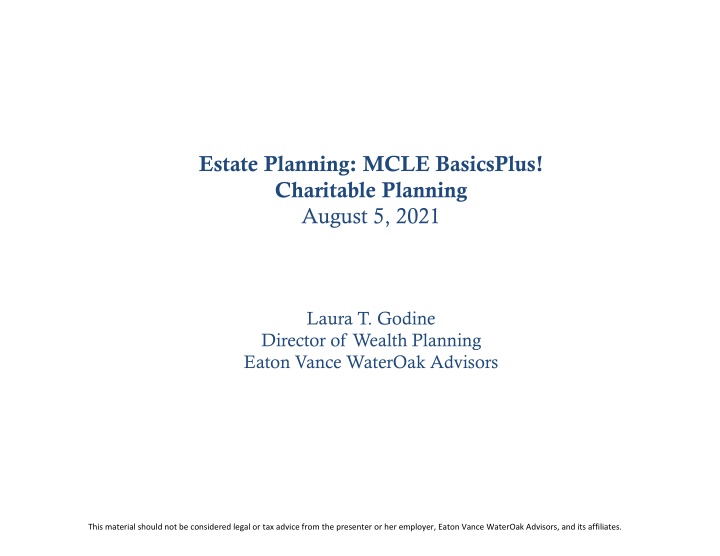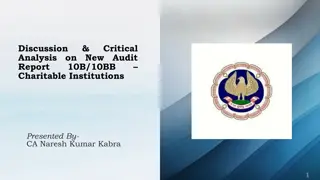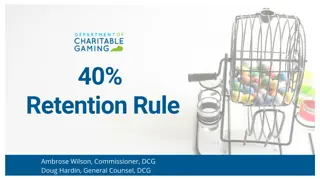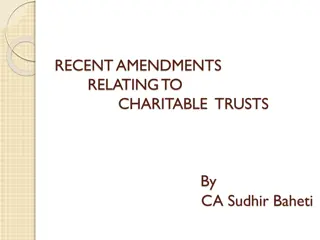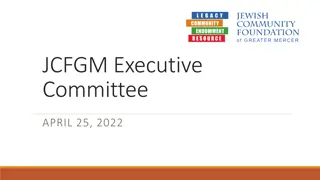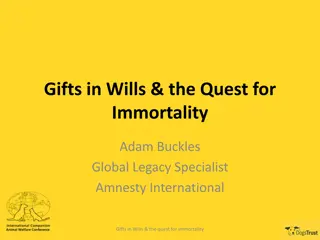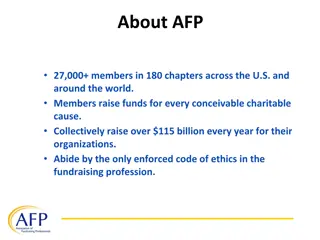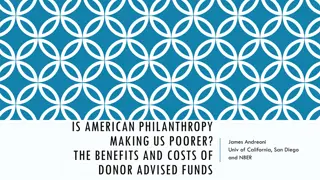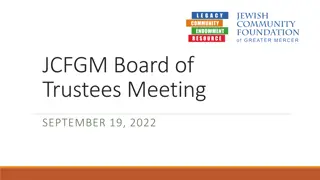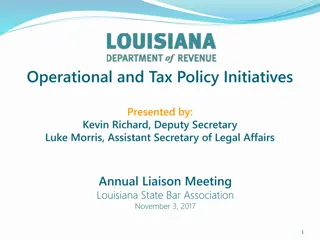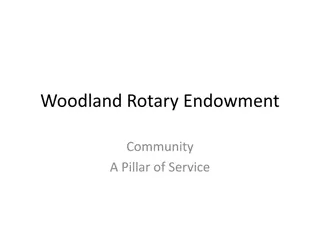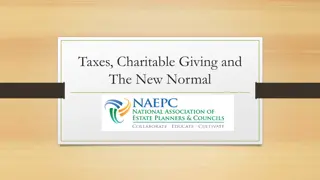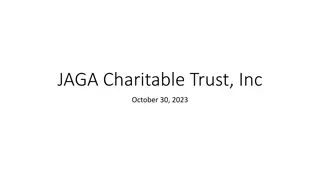Charitable Planning Overview
The basics of charitable planning, including deductions, limitations, and giving options such as donor advised funds and charitable trusts. Learn about the rules and exceptions to maximize tax benefits while supporting charitable causes.
Download Presentation

Please find below an Image/Link to download the presentation.
The content on the website is provided AS IS for your information and personal use only. It may not be sold, licensed, or shared on other websites without obtaining consent from the author.If you encounter any issues during the download, it is possible that the publisher has removed the file from their server.
You are allowed to download the files provided on this website for personal or commercial use, subject to the condition that they are used lawfully. All files are the property of their respective owners.
The content on the website is provided AS IS for your information and personal use only. It may not be sold, licensed, or shared on other websites without obtaining consent from the author.
E N D
Presentation Transcript
Estate Planning: MCLE BasicsPlus! Charitable Planning August 5, 2021 Laura T. Godine Director of Wealth Planning Eaton Vance WaterOak Advisors This material should not be considered legal or tax advice from the presenter or her employer, Eaton Vance WaterOak Advisors, and its affiliates.
Overview The Charitable Deduction Deduction Limitations Direct Giving, Donor Advised Funds and Private Foundations Charitable Remainder Trusts and Charitable Lead Trusts IRA Qualified Charitable Distribution indicates a change resulting from the 2020 Coronavirus Aid, Relief and Economic Security Act (the CARES Act ). 2021 extensions noted. indicates a change resulting from the Tax Cuts and Jobs Act ( TCJA ), which changes are currently scheduled to expire at the end of 2025. 2
The Charitable Deduction: What is it? What constitutes a charitable gift? o Charitable contribution: a transfer of money or property to a permissible donee that is both voluntary and without receipt of economic consideration or benefit and is in the proper form. o Permissible donee: any organization described in Internal Revenue Code Section 170(c) qualifies as a permissible donee for income tax purposes. 3
The Charitable Deduction: What is it not? No charitable deduction for: o Contributions to individuals. o Portion for which Donor receives a benefit (i.e. dinner, art exhibit, thank you gift, etc.) if contribution exceeds $75. o Value of Donor s time or services. o Nonqualified Organizations. o Partial Interest Rule- no deduction for a contribution of other than entire interest in property unless the contribution meets an exception 4
The Charitable Deduction: Exceptions to Partial Interest Rule General Partial Interest Rule described in prior slide. Exceptions: 1. Partial Interest Transferred to Certain Types of Trusts 2. Undivided Portion of Entire Interest in Property 3. Remainder Interest in Personal Residence or Farm 4. Qualified Conservation Donation 5
The Charitable Deduction: Income Tax Under 170 federal income tax charitable deduction available as an itemized deduction subject to certain limits. TCJA increases standard deduction to $12,550 for unmarried and $25,100 for married filing jointly (2021). Other itemized deductions eliminated or limited. Result is that far fewer taxpayers able to itemize deductions. Clients may consider bunching or funding a giving vehicle with multiple years of charitable gifts in one year in order to itemize deductions in year gift is made. For clients that do not itemize deductions, a $300 above-the-line deduction ($600 for married couples) can now be claimed for cash gifts to public charities. Donations to Private Foundations and for the establishment of a new donor advised fund or to be added to an existing donor advised fund are excluded. 6
The Charitable Deduction: Estate and Gift Tax If organization qualifies for income tax deduction under 170(c), also qualifies for gift/estate tax deduction. Estate/gift tax charitable deduction unlimited except cannot exceed amount included in estate. 7
Deduction Limitations Factors in Computing Limitations Carry Forward Charts! Substantiating the Deduction 8
Factors in Computing Deduction Limitations To determine applicable limitations, must consider: Value of property: Consider Fair Market Value and Cost Basis 1. Type of property: Cash, marketable securities, privately held business 2. interests, real estate, etc. Type of charity/vehicle: Is the gift going to a public charity, a private 3. foundation, etc.? 9
Determining Value Fair Market Value vs. Cost Basis o Generally, gifts are deductible at Fair Market Value, but there are important exceptions. The applicable value is determined by (1) type of property being contributed and (2) type of charitable organization or vehicle benefitted (more on this in a moment) o Exceptions coming up. Remember this painting 10
Exceptions to FMV Deduction Ordinary Income Property Deductible at no more than Basis: o Inventory o Life Insurance o Short-term capital gain property o Property created by Donor Tangibles deductible at FMV less gain unless used by charity for exempt purpose. o When property given for use by charity is sold by charity within 3 years, difference between deduction for FMV and for basis recaptured by taxpayer. o No recapture if good faith certification that property would be used for exempt purpose. Related v. Unrelated Use (Our Painting) o Given to the charity = Valued at Basis o Given for the use of the charity = Valued at FMV 11
Property & Charitable Vehicle: How much value can I deduct? For income tax purposes, allowable deduction is limited to certain percentage of Adjusted Gross Income (AGI). Percentage determined by type of property contributed and type of charitable organization benefitted. o 100% limitation The CARES Act temporarily increases the deduction for cash gifts to Public Charities from 60% to 100% of AGI. This temporary expansion does not apply to donations to Private Foundations or Donor Advised Funds. Extended for 2021. o 60% limitation Donor can deduct up to 60% of AGI for cash gifts to Public Charities (including Donor Advised Funds) and Private Operating Foundations. Increased under TCJA; currently scheduled to return to pre-TCJA limit of 50% on 1/1/2026. 12
Property & Charitable Vehicle: How much value can I deduct? o 50% limitation Donor can deduct up to 50% of AGI for noncash gifts to Public Charities and Private Operating Foundations. Ordinary income property Cost basis deduction Short term capital gain property Cost basis deduction Property unrelated to charity s purpose Cost basis deduction If Donor elects to deduct basis (rather than FMV) on gift of long term gain property o 30% limitation Donor can deduct up to 30% of AGI for gifts of certain property to public charity that does not qualify for 50% limit. Most non-operating private foundations, veteran s organizations, fraternal societies, and non-profit cemeteries. What Property? Long-term capital gain property to a 50% charity; For the use of the charity. E.g., Gift of publicly traded stock to public charity or donor advised fund. 13
Property & Charitable Vehicle: How much value can I deduct? o 20% limitation Donor can deduct up to 20% of AGI for gifts of other capital gain property to an organization not qualified for 50% limitation. Deduction limited to basis for any contribution other than publicly traded securities. Eg., Privately held interests to non-operating private foundation. 14
Carry Forward of Excess Contributions A Donor may carry over any contributions they can't deduct in the current year because they exceed the AGI limits. o 5 year carry forward o Retains character as original percentage limitation o Current year gifts factored before carry-over amounts o Excess carry-forward expires upon death o A carryover of a qualified conservation contribution can be carried forward for 15 years 15
Quick Reference: Deduction Limitations Direct to Public Charity Donor Advised Fund Private Foundation Amount Deductible Appreciated property (publicly traded stock) Fair Market Value* Fair Market Value* Fair Market Value* Other appreciated property Fair Market Value* Fair Market Value* Cost Basis Contribution Percentage Limitations (of adjusted gross income) 60% Cash gifts 100% 30% Ordinary income property; short- term capital gain property; * property unrelated to charity s purpose; property on which donor elects to deduct basis rather than FMV 50% 50% 30% Capital gain property 30% 30% 20% Carry-over available (5 year) Yes Yes Yes 2021 extension of CARES Act provision Under TCJA will revert back to 50% on 1/1/2026 +hlk* 16
Substantiating the Deduction Deduction under $250: Donor must have reliable written records. Deduction over $250: Charity must provide acknowledgment. Forms 8283 & 8282 substantiate deduction for noncash gifts over $500. Donor files Form 8283 in year of gift; Receiving charity files form 8282 if asset sold within three years of receipt. Failure to file can result in disallowance of deduction and penalty. Deduction $500- $5,000: Form 8283, Sec. A reports info. about gifts for which Donor claimed deduction of $5,000 or less per item or group of similar items. Deduction over $5,000 if publicly traded securities: Form 8283, Sec. A. Deduction over $5,000 if other property: Form 8283, Sec. B. reports info. about gifts for which Donor claimed deduction of over $5,000 per item or group of similar items. Qualified appraisal required. 17
Direct Giving We generally think of direct giving as making a one-time contribution directly to a public-serving 501(c)(3) o These include religious, scientific, educational, charitable institutions, etc. Donor receives charitable tax benefits because a public purpose is served CARES Act Incentives (direct gifts of cash) 18
Donor Advised Funds Donor Advised Fund: A philanthropic vehicle established at a public charity. Donor makes a charitable contribution, may receive an immediate tax benefit (consider bunching ) and then recommends grants from the fund over time. Typically offered by: National Gift Funds, Community Foundations, Single Issue providers The Dollaire family recommends grants to their favorite charitable causes. Subject to: o Excess benefit rules o Excess business holdings rules Penny and Cash Dollaire donate assets; may receive charitable deduction Assets are invested and grow tax free in The Dollaire Family Charitable Fund 19
Donor Advised Funds National Gift Funds: o Some financial service companies sponsor donor advised fund programs. o Some may provide philanthropy support services above certain level. Single Issue Providers: o Religious Affiliate Philanthropies; Universities, and more. o Some may provide philanthropy support services above certain level Community Foundations: o Additional Giving Options: General Fund/Endowment; Designated Fund; Field of Interest Fund; Annual Fund. o Typically provide philanthropy support services and programmatic expertise. 20
Private Foundations Private Foundation: Separate legal entity that must be approved by IRS as a 501(c)(3) organization. Receive funds from one or few sources such as an individual, family or business. o Maximum Control of Investments and Grants o Legacy / Perpetuity o Subject to: Excise Tax Payout Requirement Tax Filings Private Foundation rules: Self-dealing Excess business holdings Jeopardy investments Taxable expenditures 21
Key Differences: Donor Advised Funds & Private Foundations Donor Advised Funds Private Foundation Start-up Costs and time None and can be established immediately Legal and start-up fees can be substantial; weeks or months to create Income tax deduction More favorable (See chart on slide 16) See chart on slide 16 Ongoing Administrative and Management Fees Varies with sponsoring charity and level of services; customarily less than private foundations Varies with choice of board and level of service; Must file tax returns, conduct independent audit, administer all functions Excise Tax None Flat tax = 1.39% of annual net investment income* Annual required distribution of principal to charitable organizations None Must expend 5% of net assets value annually Privacy Grants can be made anonymously Must file detailed public tax return on grants, investment fees, trustee name, staff salaries, etc. This information, including donor names, is publicly available Recommend grants to favorite charitable causes Manage assets, keep records, select charities, administer grants, file annual state and federal tax returns, maintain board minutes, etc. Donor s administrative responsibilities Varies with sponsoring charity. Typically a handful of options with separately managed accounts available above a certain threshold Typically greater investment flexibility Donor s Investment options * Revised by the Setting Every Community Up for Retirement Enhancement Act of 2019 (the SECURE Act ). Formerly a two tier excise tax system of 1% or 2%. 22
Charitable Remainder Trusts & Charitable Lead Trusts Charitable Remainder Trust (CRT): Irrevocable Trust created during life or at death with the leading interest in the form of an annuity or unitrust payment to the Donor or other non-charitable beneficiaries, remainder to charitable beneficiaries. Charitable Lead Trust (CLT): Irrevocable Trust created during life or at death with the leading interest in the form of an annuity or unitrust payment to charitable beneficiaries, remainder to Donor or other non-charitable beneficiaries. Leading Interest: o If Annuity Interest=fixed, non-fluctuating dollar amount. o If Unitrust Interest = variable, fluctuating amount based on investment performance, revalued annually. Term of Trust: o CRT- Term can be measuring life or lives, or term of years (max 20 years). o CLT- Term can be term of years (no limit on number of years) or measuring life or lives, or combination of two (i.e., life of an individual followed by term of years). 23
Charitable Remainder Trusts (CRATs) Fixed payout amount that is either a fixed dollar amount or a fixed percentage of the initial assets contributed by the Donor. Annual annuity amount must be at least 5% but less than 50% of the initial FMV of the property contributed. CRATs must pass two tests: 1. Actuarial Value: Charitable remainder must be at least 10% of the value of the assets contributed. 2. Probability of Exhaustion: IRS has ruled that a trust is not a CRAT if there is a >5% chance the trust fund will be exhausted before the trust ends. Or: CRATs created after August 8, 2016 have option to include early termination provision if next annuity payment will cause trust to fall below 10% of original value. Exempts CRAT from test 5% probability of exhaustion test. 24
Charitable Remainder Trusts Charitable Remainder Unitrusts ( CRUTs ) CRUTs pay the income beneficiary a fixed percentage of the FMV of the trust assets valued annually (the unitrust amount ). Subject to 10% Minimum Remainder Interest Rule. Variations on a CRUT & when a Donor might want one NICRUT (net income CRUT) o Pays out the lesser of the trust s net income or the unitrust percentage. o Suitable for a Donor focused on providing charity with maximum amount of principal at end of trust term. o Also suitable for trust funded with low-yielding property expected to pass intact to the charity (i.e. real estate that the charity will use). 25
Charitable Remainder Trusts Variations on a CRUT Cont d. NIMCRUT (net income with make-up provision CRUT) o NICRUT plus make-up provision - if income in particular year exceeds unitrust amount, excess paid out to compensate for any prior year shortfalls. o Suitable if expect significant amount of investment return will be post- contribution capital gains; because post-contribution gains may be included in trust income, make-up amount can be satisfied as investments are sold. o Suitable for a Donor who does not have a current need for income, but may want some in the future. FLIPCRUT (starts out as a NICRUT or NIMCRUT, triggering event flips it to a regular CRUT). o The flip must be triggered on a specific day or by an event not within the discretion or the control of any person, such as sale date of an unmarketable asset, a beneficiary s birthday, marriage, or birth of a child. A typical example is the sale date of stock in a closely-held company. o Often used if trust is funded with an illiquid asset (land, closely-held stock) but Donor would like a more consistent stream of income after the asset is sold. Not stuck with a NICRUT or NIMCRUT after sale of asset, trustee can focus on total return. o Reverse flip not permitted. 26
CRUTs and CRATs: Income Tax Consequences Charitable Deduction: Donor receives income tax charitable deduction when the property is transferred into the CRT. CRUT typically yields larger charitable deduction than CRAT when payout percentage exceeds the 7520 rate in effect when gift is made. CRATs are responsive to fluctuations in the 7520 rate. A lower 7520 rate yields a smaller charitable deduction for the remainder interest of the CRAT. CRUTs are generally not responsive to changes in the 7520 rate unless term of the trust is based on the life expectancy of a young beneficiary, in which event the CRUT may fail the 10% charitable remainder requirement. 27
CRUTs and CRATs: Income Tax Consequences Income Taxation to Non-charitable Beneficiaries: No Gain Recognition on Funding. Income paid to beneficiaries subject to taxation based on the source of funds used to make the payment. Dollars paid to beneficiaries retain their tax character. Four Tier Payout Rule requires that income gets paid in the following order: 1. 2. 3. 4. ordinary income capital gain income tax-exempt. tax-free Some clients consider naming CRT as beneficiary of IRA to create a version of stretch payout eliminated under SECURE Act. 28
CRUTs and CRATs: Gift, Estate and GST Consequences Gift Tax Consequences: o Giving the taxable income interest to a non-charitable beneficiary other than the Donor or the Donor s U.S. citizen spouse is a taxable gift. o Gift tax may not be currently payable to the extent the Donor s gift and estate tax exemption is available. Generation-Skipping Transfer (GST) Tax Consequences: o A gift to a CRT has GST tax consequences if a non-charitable beneficiary is a skip person. o GST exemption can be allocated upon funding. Estate Tax Consequences: o Remainder value typically not included in the Donor s gross estate. o If the Donor retains an interest for a term of years and dies before the term s expiration, the value of the property is included in the estate, with a charitable deduction allowed for the value of the charitable remainder. 29
Charitable Lead Trusts Donor makes gift into trust, leading interest to charitable beneficiaries, remainder to non-charitable beneficiaries. Unlike CRTs, no minimum or maximum annuity or unitrust payout rates apply. Charitable Lead Annuity Trusts (CLATs): o Fixed payout amount must be ascertainable at the outset. o Can be zeroed out- term and payout set such that gift tax charitable deduction fully offset gift into CLAT. o Additions not prohibited, but no additional tax benefit. o Allocation of GST exemption upon funding less reliable (late allocation upon termination (or CLUT) may be better option). Charitable Lead Unitrusts (CLUTs): o Fixed percentage of market value calculated annually. o Cannot be zeroed out because amount going to charity unknown at outset. o Additions allowed. o GST exemption can be allocated upon funding. 30
Grantor vs. Nongrantor CLTs Grantor CLT: Primary Motive Typically Income Tax Planning Immediate income tax charitable deduction. o The lower the interest rate, the lower the present value of the remainder gift, or correspondingly, the larger the present value of the charitable lead interest, meaning a higher income tax deduction for the Donor. o If the trust assets outperform the estimated rate of return based on these low interest rates, the remainder beneficiaries would also receive considerable assets while using minimal federal estate and gift tax exemption. Income tax deduction limitations apply. All income taxed to Grantor with no offsetting charitable deduction. Certain retained interests may cause includibility in the Donor s estate. 31
Grantor vs. Nongrantor CLTs Nongrantor CLT: Primary Motive Typically Transfer Tax Planning No income tax charitable deduction. Immediate gift tax charitable deduction if created during life; estate tax charitable deduction if testamentary. Separate taxable entity; Trust pays its own income tax during term. Grantor relinquishes control; Contributed assets and all appreciation removed from Grantor s estate. 32
IRA Qualified Charitable Distribution Qualified Charitable Distribution (QCD) = Direct transfer of funds from IRA custodian to a qualified charity. QCD can count toward required minimum distributions (RMDs) if certain rules are followed. Excludes amount donated from taxable income (unlike regular IRA withdrawals). Must be 70 or older. o QCD age remains unchanged despite SECURE Act increase of required beginning date for RMDs to age 72. Maximum annual amount that can qualify for a QCD is $100,000. o If an individual with earned income makes tax-deductible contributions to a traditional IRA after age 70 , however, the $100,000 per year QCD limit is reduced by the amount of deductible IRA contributions. 33
Thank you! Discussion/Q&A This material should not be considered legal or tax advice from the presenter or her employer, Eaton Vance WaterOak Advisors, and its affiliates.
